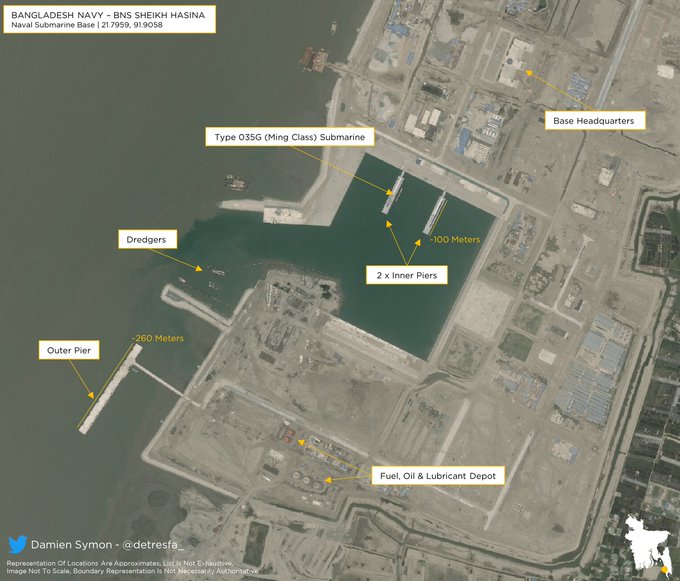
- China’s strategic interest in Bangladesh is around securing access to the Bay of Bengal as part of its larger ‘String of Pearls’ strategy.
- The BNS Sheikh Hasina submarine facility in Cox’s Bazar, developed with Chinese technology and funding, gives China potential future access to naval facilities in the strategically crucial Bay of Bengal.
- The recent Chinese investment of $400 million in Mongla Port renovation is an important strategic move.
- The real issue is debt: Bangladesh owes China $5.34 billion, with another $5 billion in soft loans requested to boost its shrinking foreign reserves. Unlike the World Bank and ADB, China offers shorter 10–15-year repayment terms instead of 25.
The regime change in Bangladesh has done more than simply shift political gears. With Muhammad Yunus at the helm, Dhaka has shifted from hedging to aligning, placing its bets fully with Beijing. For India, this is more than just a foreign policy annoyance. It faces a live strategic challenge on its eastern flank. But let’s be clear: this is not unfamiliar territory for New Delhi. The stakes are enormous, and so is the playbook.
China’s Deepening Strategic Grip
Since Yunus took power, China has moved quickly to consolidate its position. Bangladesh has inked new arms deals with Beijing, doubling down on Chinese-made military equipment. Currently, China supplies nearly 80 per cent of Bangladesh’s arsenal,[1] which includes tanks, jets, submarines, and warships. More are on the pipeline, including J-10 fighter jets, Type 056 corvettes, and strengthened ground-based air defence systems.
Military ties have expanded in record time. The Golden Friendship-2024 counterterrorism drills were more than simply symbolic exercises; they were the first time Bangladeshi and Chinese special forces collaborated in an urban combat simulation. Chinese commandos conducted demonstrations on drone surveillance, electronic warfare, and riot control, while Bangladeshi soldiers gave counterinsurgency training based on their experiences in the Chittagong Hill Tracts. This was not a routine drill. It was a dry run to ensure joint operability. What about the follow-up? Plans call for frequent cooperative naval patrols in the Bay of Bengal, more logistics sharing, and enhanced intelligence coordination.[2]
Ports, Bases, and the “String of Pearls”
China’s strategic interest in Bangladesh is around securing access to the Bay of Bengal as part of its larger “String of Pearls” strategy. China has spent considerable money on renovating Chittagong Port, Bangladesh’s main seaport that handles 90% of the country’s traffic. Chinese businesses have received billion-dollar building contracts and continue to play an operational role in the port’s development. [3]The recent Chinese investment of $400 million in Mongla Port renovation is an important strategic move. This deep-water port provides China with another potential entry point into the Bay of Bengal.[4]
The BNS Sheikh Hasina submarine facility in Cox’s Bazar, developed with Chinese technology and funding, gives China potential future access to naval facilities in the strategically crucial Bay of Bengal. The base’s location near the mouth of the Bay of Bengal brings it dangerously close to India’s Andaman and Nicobar Command.[5]
What’s the risk? These facilities can be dual-purpose at any time. Civilians today, strategic outposts tomorrow. Then there’s the Lalmonirhat Airbase project, a World War II-era facility. This idea, located just 135 kilometres from India’s Siliguri Corridor (the Chicken’s Neck), is the most daring. If developed with Chinese money and technology, it would put the PLA near one of India’s most important logistical routes. Beijing does not need troops on the ground. Control of infrastructure, logistics, and ISR (intelligence, surveillance, and reconnaissance) capabilities is sufficient.[6]
The Debt Playbook
Bangladesh fully joined the Belt and Road Initiative in 2016, immediately following Xi Jinping’s high-profile visit to Dhaka, which resulted in $24 billion in deals.[7] Since then, China has promised about $40 billion to Bangladesh, but only around $4.45 billion has been disbursed over a decade for 35 infrastructure projects.[8] The Chinese brand appears on the majority of big-ticket items, including the Padma Bridge Rail Link, coal power plants, and national highways. [9]
That’s not just investment. That’s strategic leverage. The second source of pressure is trade. For the past 12 years, China has been Bangladesh’s leading commercial partner.
However, the trade balance is cruelly distorted. Bangladesh imports $22.9 billion from China and exports only $677 million. Dependency, not partnership.[10] On the ground, 670 Chinese enterprises now operate in Bangladesh, supporting approximately 550,000 jobs, and China has established a 783-acre special economic zone in Anwara, Chittagong.
However, the real kicker is debt. Bangladesh now owes $5.34 billion to China[11]. That figure is growing, with new requests for an additional $5 billion in soft loans to shore up its dwindling foreign exchange reserves. Unlike the World Bank and the Asian Development Bank, Beijing’s loans have repayment terms of 10-15 years rather than 25. A shorter leash is a firmer grasp.
670 Chinese enterprises now operate in Bangladesh, supporting approximately 550,000 jobs, and China has established a 783-acre special economic zone in Anwara, Chittagong.

India: Not Cornered, But Cautioned
The Yunus Government in Dhaka is unlikely to return to Delhi very soon. And honestly, India needs to stop wishing it would. It must now embrace the new balance of power and play better with the tools it already possesses. Regional diplomacy must come off autopilot. India will expand its outreach not only to Bangladesh’s civil society and opposition parties, but also through quiet, long-term contacts with bureaucracy, business, and youth organisations. Expect more scholarships, training exchanges, and media collaborations to gradually reshape the narrative.
On the economic front, New Delhi cannot compete with China dollar for dollar, but it does not have to. The answer will be strategic: smaller, faster expenditures that have a meaningful impact on power grids, highways, and data centres, particularly in locations that China ignores. Security-wise, the pivot has already begun. Expect additional Indian naval deployments in the Bay of Bengal[12]. Expect stronger intelligence links with Japan, the United States, and Australia.[13] Expect discreet cooperation from Myanmar, Vietnam, and even Indonesia.[14] The Andaman and Nicobar Command is currently more important than ever.[15]
Conclusion
China may have reinforced its hold over Bangladesh. However, India has not lost the plot. The strategic issue is serious, but not irrevocable. Bangladesh may find it too late that China provides short-term bargains with long-term conditions. Meanwhile, India employs a long-term strategy. With patience, pressure, and precision, it can withstand this change and wait for the pendulum to swing back.
Because in South Asia, affiliations shift. However, geography and history do not.
References:
- [1] Report: China has transferred military technology to Bangladesh
- [2] China, Bangladesh to host joint exercise Golden Friendship-2024: Defense Spokesperson
- [3] May have implications on India’s stability’: CDS warns of China-Pakistan-Bangladesh axis
- [4] Govt selects Chinese firm to expand the facilities at Mongla Port
- [5] Bangladesh Unveils Maiden Submarine Base Built With Chinese Assistance
- [6] https://youtu.be/tJnFqmlTbhc?feature=shared
- [7] Belt and Road Initiative: An Opportunity for Bangladesh
- [8] Belt and Road Initiative: China releases $4.45b in 10 years for Bangladesh
- [9] Geopolitical chessboard: China’s Belt and Road Initiative and shifting power dynamics
- [10] China’s Expanding Influence in Bangladesh: Strategic Debt and Naval Ambitions
- [11] China’s Expanding Influence in Bangladesh: Strategic Debt and Naval Ambitions
- [12] ‘Indian Navy deploying cutting-edge undersea surveillance network in Indian Ocean Region’
- [13] The Quad Is Quietly Adapting Methods of Security Cooperation
- [14] India to Give Vietnam Warship as the Two Countries Tighten Defense Ties
- [15] The Long Littoral Project: Bay of Bengal A Maritime Perspective on Indo-Pacific Security
Pranav S is a Project Assistant at the Energy Department, Government of Karnataka with an MA in Public Policy. Views expressed are the author’s own.
